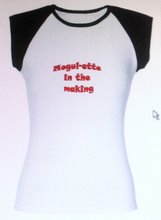
I've been working on a new logo for my Mogulette Blog (coming soon!) which has led me to think a lot about my brand and what direction to take it. I get so confused by all the different aspects of my business and how they're changing and how (or if) to connect them to one another. So I checked in with my branding guru, the very talented Romana Mirza (who is founder of her own firm, Studio Pinpoint) to shine some light on these matters. Her recommendation for entrepreneurs that are still testing their product/service mix is to start out by making a list of words. Here's what she had to say:
There’s a 3-dimensional perspective that all visionary leaders need to have when building their brands. First you review the strengths of your competitors, then your own and finally those of brands outside of your industry.
1. Competitive landscape: Know what your competitors are offering. Not just the factual details like price, selection, service delivery, etc. but also the language they use - “fastest”, “best quality”, “luxury”, “softest”, “tastiest” – whatever it is. You will find that all your competitors speak the same way. Note these similar phrases and descriptive words. If you don’t have a competitor then fast forward to a time when you become really successful and try to figure out which companies will want to jump into your space and become your competitors, and summarize their language and common phrases.
2. Look inside: Define your character, your personality, what’s unique or quirky about you – how are you are different from the next person. This is hard to do and that’s where working with a brand strategist really helps. Ask your friends, your colleagues, your partners. Make sure to get them to tell you what is unique about you in all the different areas of your life: family, work, business partners, friends, acquaintances, etc. Note the differences, the unique attributes. I really liked Strengths Finder 2.0 by Tom Rath - it's a great way to get an objective view of your strengths.
3. Benchmark: Look for your favorite brands in industries outside of your business. For instance I was hired to do the brand repositioning for a very large office furniture manufacturer. This company appealed to the masses and offered nice design, so I looked for an established brand that had those same qualities to see how they went to market with their designs and how they targeted their customers. Kenneth Cole, which was in a totally different field, ended up being my benchmark. Study your favorite brands, whether it's a tennis racquet manufacturer, clothing designer, a soap company or a car company. Look at their websites, note the language they use to speak to customers, figure out what you like about how they present themselves to you and take note.
Once you complete noting the three dimensions, lay out what you found in front of you. This is where you'll see your brand coming together. Your business may be in flux, your distribution model may change or your financing methods may vary but one thing is certain - no matter how many structural or operational changes you make, your brand should always remain consistent. This is the most important part. The brand must reflect who you are, your core values, the core culture of the company you are building. In the early stages the three-dimensional perspective will give you that.
I then asked Romana for guidance in helping "slashers" like myself (people with multiple slashes in their job titles) to create our brands. Specifically I wanted to know if it was better to tie in the different roles we play into one single brand, or create separate ones for each. Here's what she said:
Develop a brand strategy. This is where you create an “organizational chart” of your different areas of expertise. If in doing this exercise one emerges as the “parent skill” then your other slashes will become subsets of that. If they truly emerge as individual silos then your brand effort may also have to be individualized. Write your strategy - it will determine your “go to market” approach.Romana says there millions of dollars spent on marketing and brand strategies that don’t work. "Most of the time campaigns are so out of touch from the intent and culture of their organization they don’t even make it to market. Then a company has to invest even more money to try to get it right, but by that point they are so fatigued they just launch whatever comes next. We need to change that," she adds.
Here's her list of 4 branding pitfalls to watch out for:
1. Avoid “standard industry language”. If everyone is talking about luxury, quality and craftsmanship then you should use other words like elite or best-in-class, care, attention-to-detail, and skill.Branding takes a lot of soul searching and self-analysis and may be the last thing you want to do when there's so many other pressing matters to take care of for your business, but all that precious time spent in careful thought and planning will definitely be worth it.
2. Don’t be something you’re not. Some new companies take on a persona, a brand personality that is not a reflection of who they truly are. People will want to be seen as “worldly and exciting” when they are really “approachable and skilled”. Don’t get caught in the ad agency ‘fast talk’ and adopt an ad campaign or look that doesn’t reflect who you are.
3. Don’t go in blindly. It shocks me how little knowledge entrepreneurs have of their competitive marketplace. Everyone starts a business thinking they have the most unique product. If that is the case then study those companies that are going to come after your market share once they see how successful you’ve become.
4. Be strategic. Throwing an identity and company name together without understanding the strategic implications of how the business is going to grow and what it is going to look like when you get there feels like you are accomplishing a lot in the moment. But then once you get there - to your future state - you realize all the mistakes you made. I work with many, many entrepreneurs – all in their 50’s - who didn’t focus on long term strategy in their 20’s, 30’s or 40’s when they launched their businesses so now they have to do everything all over again.
What are your favorite brands, and why? Please share!













3 comments:
Dina Lynch Eisenberg said...
Great advice, especially the benchmarking because there's no reason to reinvent the wheel.
As I build my media company, Yoomer Media, and it's first blog, ThisMarriageThing.com, I struggled with putting language around my brand. That is until I read two questions John Jansch of DuckTape Marketing asked:
1. What experience do you want to offer?
2. What's your promise?
Like the flick of switch, I knew that I wanted to give people the experience of 'knowing deepmjoy'. That just means recognizing on a conscious, grateful level that your life (and marriage) is fine and happy. Oftentimes we're so busy it goes unnoticed.
My promise is to use my blog to: help couples remember the positive reasons they married that person, why they wanted to spend the rest of their lives together.
I'm feeling energized and motivated now that I know my purpose, and hope other mogulettes will feel the same.
Thanks
This was an incredibly useful article. I appreciated the concise and rich guide to where to start and what to look out for. I am thoroughly inspired to go looking for benchmark companies!
Thanks for your comment on my blog Carmina. I'm always happy to link back and cover high quality blogs like yours. You always have useful and inspiring articles that enable me to think about my own business and direction. Keep up the great work! Stay motivated and inspired...I know it's sometimes difficult, but people like me are always checking back to see what you have!
Post a Comment